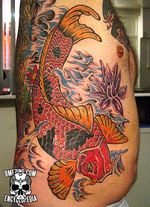Koi

Koi is the the shortened term for Nishikigoi, the Japanese word for carp. Although decorative koi were first cultivated in Imperial China, they arrived in Japan during the 8th century CE and have been highly regarded as pets ever since. Today, a prize koi in Japan can command tens of thousands of dollars at auction, with those specimens displaying a round blood-red mark on the head with a pure white body, which represents the flag of Japan. In China, the legend of 'Climbing the Dragon Gate' recounts how koi carp that can scale the waterfalls of the Yellow River turn into dragons. In Imperial China, students sitting the civil service entrance exams were said to be attempting to 'scale the waterfall'; those who passed were allowed to wear clothes printed with a three-clawed dragon design as a symbol of their station.
In Japanese culture, koi carp represent perseverance and bravery. Their whiskers also denote wisdom. For example, on the public holiday known as Children's Day, tubular flags fashioned in the shape of koi are flown in the hope that the children, too, will grow up to be as strong and resilient as koi carp. In some rural villages, capturing koi with one's bare hands (Koi Tsukami) is a rite of passage for young boys.
Traditionally, a koi tattoo would be done on the forearm or leg of a young man in the hopes that later on in his life he would be able to 'earn' a dragon for his final back piece. Because of this and their marked appearance within Japanese folklore, the koi carp remains a very popular design for horimono tattoos. Different types of koi (coloring, whisker quantity, scaling) symbolize different wishes for a young man's future, to be strong, to be great, to be loyal, etc. Tancho koi, a white koi with a single red spot on the head, can sometimes connote national pride as well as desire to be great. The tancho koi is prized among collectors for its resemblance to the Japanese national flag.
